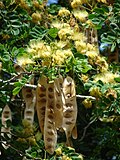Albizia lebbeck
Species of plant
Albizia lebbeck, commonly known as the Lebbeck, Frywood, Koko, or Woman's Tongue Tree, is a species of legume in the family Fabaceae. It is native to tropical and subtropical regions of Asia and Australia.
Description[edit]
Albizia lebbeck is a deciduous tree that can grow up to 30 meters tall. The bark is grey and smooth, as shown in the image

. The leaves are bipinnate, with each leaf having 2 to 4 pairs of pinnae, and each pinna having 3 to 9 pairs of leaflets. The flowers are fragrant, with long stamens that give them a distinctive appearance. The fruit is a flat pod containing several seeds.
Distribution and habitat[edit]
Albizia lebbeck is found in a variety of habitats, including tropical and subtropical forests, savannas, and grasslands. It is often planted as an ornamental plant in gardens and along roadsides due to its attractive flowers and shade-providing canopy.
Uses[edit]
The wood of Albizia lebbeck is used for timber and firewood. The tree is also valued for its medicinal properties in traditional medicine. The bark, leaves, and seeds are used in various herbal remedies.
Ecological importance[edit]
Albizia lebbeck plays a role in nitrogen fixation, improving soil fertility. It provides habitat and food for various wildlife species, including birds and insects.
Cultivation[edit]
Albizia lebbeck is cultivated in many parts of the world for its ornamental value and its ability to improve soil quality. It is tolerant of a wide range of soil types and can withstand drought conditions.
Related pages[edit]
Gallery[edit]
-
Albizia lebbeck tree
-
Bark of Albizia lebbeck
Albizia_lebbeck[edit]
-
Albizia lebbeck foliage and flowers
-
Bark of Albizia lebbeck
Ad. Transform your life with W8MD's Budget GLP-1 injections from $75


W8MD offers a medical weight loss program to lose weight in Philadelphia. Our physician-supervised medical weight loss provides:
- Weight loss injections in NYC (generic and brand names):
- Zepbound / Mounjaro, Wegovy / Ozempic, Saxenda
- Most insurances accepted or discounted self-pay rates. We will obtain insurance prior authorizations if needed.
- Generic GLP1 weight loss injections from $75 for the starting dose.
- Also offer prescription weight loss medications including Phentermine, Qsymia, Diethylpropion, Contrave etc.
NYC weight loss doctor appointmentsNYC weight loss doctor appointments
Start your NYC weight loss journey today at our NYC medical weight loss and Philadelphia medical weight loss clinics.
- Call 718-946-5500 to lose weight in NYC or for medical weight loss in Philadelphia 215-676-2334.
- Tags:NYC medical weight loss, Philadelphia lose weight Zepbound NYC, Budget GLP1 weight loss injections, Wegovy Philadelphia, Wegovy NYC, Philadelphia medical weight loss, Brookly weight loss and Wegovy NYC
|
WikiMD's Wellness Encyclopedia |
| Let Food Be Thy Medicine Medicine Thy Food - Hippocrates |
Medical Disclaimer: WikiMD is not a substitute for professional medical advice. The information on WikiMD is provided as an information resource only, may be incorrect, outdated or misleading, and is not to be used or relied on for any diagnostic or treatment purposes. Please consult your health care provider before making any healthcare decisions or for guidance about a specific medical condition. WikiMD expressly disclaims responsibility, and shall have no liability, for any damages, loss, injury, or liability whatsoever suffered as a result of your reliance on the information contained in this site. By visiting this site you agree to the foregoing terms and conditions, which may from time to time be changed or supplemented by WikiMD. If you do not agree to the foregoing terms and conditions, you should not enter or use this site. See full disclaimer.
Credits:Most images are courtesy of Wikimedia commons, and templates, categories Wikipedia, licensed under CC BY SA or similar.
Translate this page: - East Asian
中文,
日本,
한국어,
South Asian
हिन्दी,
தமிழ்,
తెలుగు,
Urdu,
ಕನ್ನಡ,
Southeast Asian
Indonesian,
Vietnamese,
Thai,
မြန်မာဘာသာ,
বাংলা
European
español,
Deutsch,
français,
Greek,
português do Brasil,
polski,
română,
русский,
Nederlands,
norsk,
svenska,
suomi,
Italian
Middle Eastern & African
عربى,
Turkish,
Persian,
Hebrew,
Afrikaans,
isiZulu,
Kiswahili,
Other
Bulgarian,
Hungarian,
Czech,
Swedish,
മലയാളം,
मराठी,
ਪੰਜਾਬੀ,
ગુજરાતી,
Portuguese,
Ukrainian

